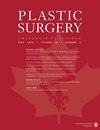简化儿童简单手部损伤的处理程序
IF 0.7
4区 医学
Q4 SURGERY
引用次数: 0
摘要
背景介绍手部损伤在儿童中很常见。大多数简单的小儿手部骨折不需要手术治疗,只需进行保护性固定即可,疗效良好。最近的一项机构审计显示,这些儿童的治疗方法存在很大差异,许多儿童接受了过度治疗,并进行了不必要的复诊。本研究的目的是实施和评估一种简化的护理路径,以管理 "简单 "的小儿手部损伤,并最大限度地减少医疗保健的使用。研究方法对简化护理路径进行单一机构前瞻性研究。简单的手部损伤包括外侧骨板损伤、指骨 Salter-Harris 2 型骨折、掌骨颈骨折、单皮质和扣骨骨折、近端指间脱位以及拇指韧带损伤。患者接受热塑夹板或拇指绑带治疗。提供标准化的口头和书面指导。未安排常规随访。受伤 6 周后,我们会通过电话联系参与者,以确定他们是否有任何顾虑或需要进行后续治疗。结果:共有 101 名简单手部受伤的儿童参加了调查。61 名参与者完成了电话调查。约 90% 的儿童在愈合期间没有出现任何问题,85% 的儿童恢复了所有活动。有 10 名参与者要求复诊,但其中 4 人取消了复诊,其余 6 人只需再次确认,无需额外治疗。结论:大多数简单的小儿手部损伤都能通过包扎或夹板固定很好地愈合。所描述的简化手部治疗路径可以避免不必要的简单小儿手部创伤后续治疗,减轻家庭和医疗系统的负担。本文章由计算机程序翻译,如有差异,请以英文原文为准。
Streamlining the Management of Children With Simple Hand Injuries
Background: Hand injuries are common in children. Most simple pediatric hand fractures do not require surgery and can be treated with protective immobilization, yielding good outcomes. A recent institutional audit revealed significant practice variation in managing these children with many being overtreated with unnecessary follow-up visits. The objective of this study was to implement and assess a streamlined care pathway to manage “simple” pediatric hand injuries and minimize healthcare utilization. Methods: A single institution prospective study of the streamlined care pathway was conducted. Simple hand injuries included volar plate injuries, phalangeal Salter-Harris type 2 fractures, metacarpal neck fractures, unicortical and buckle fractures, proximal interphalangeal dislocations, and thumb ligamentous injuries. Patients were treated with either thermoplastic splinting or buddy taping. Standardized verbal and written instruction were provided. No routine follow-up was arranged. Participants were contacted by telephone 6 weeks post-injury to identify any concerns or need for follow-up. Results: A total of 101 children with simple hand injuries were included. Sixty-one participants completed the telephone survey. About 90% had no problems during healing and 85% resumed all activities. Ten participants requested follow-up; however, 4 cancelled and the remaining 6 required reassurance with no additional treatment. Conclusions: Most simple pediatric hand injuries heal well with buddy taping or splint immobilization. The described streamlined hand pathway can avoid unnecessary follow-ups for simple pediatric hand trauma, reducing the burden on both families and the healthcare system.
求助全文
通过发布文献求助,成功后即可免费获取论文全文。
去求助
来源期刊

Plastic surgery
Medicine-Surgery
CiteScore
1.70
自引率
0.00%
发文量
73
期刊介绍:
Plastic Surgery (Chirurgie Plastique) is the official journal of the Canadian Society of Plastic Surgeons, the Canadian Society for Aesthetic Plastic Surgery, Group for the Advancement of Microsurgery, and the Canadian Society for Surgery of the Hand. It serves as a major venue for Canadian research, society guidelines, and continuing medical education.
 求助内容:
求助内容: 应助结果提醒方式:
应助结果提醒方式:


